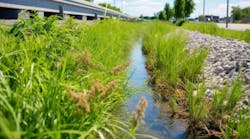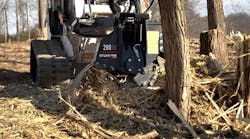When Jerry Peterson purchased the Manistee County Road Commission’s first hydroseeding machine in the summer of 2003, he had no idea how useful it would prove. But the machine, a Hydrograsser from Plainfield, NJ–based Reinco, has helped the Michigan road commission seed miles of roadsides hugging Lake Michigan, quickly add vegetation to newly built stream culverts, and turn formerly bare ditches a healthy green.“We don’t regret buying the hydroseeding machine, by any means,” says Peterson, manager of the road commission. “In fact, we think it will end up saving us money over the long haul.”Peterson is hardly alone. Developers, Department of Transportation (DOT) employees, contractors, golf course superintendents, and other industry professionals more frequently than ever are turning to hydroseeding as an efficient means of quickly adding grass or other vegetation to the bare patches of earth left behind during construction projects. The reason is simple: Growth must take place quickly in these areas to prevent exposed soil from eroding. Federal, state, and local regulatory agencies also are imposing stiffer rules requiring developers, builders, and DOTs to prevent sediment from leaving construction sites and seeping into storm drains, streams, rivers, lakes, and other sensitive areas. Hydroseeding happens to be one of the most efficient and cost-effective ways to meet these tougher regulations.Because it allows workers to quickly spray a slurry mixture of seed and water over large areas, hydroseeding is a relatively inexpensive process. It also takes contractors far less time to hydroseed an area than it does for them to plant sod or apply erosion control blankets. Peterson discovered these benefits early on. Although most of the projects to which he sends his commission’s hydroseeding machine are fairly routine, he and his employees also have discovered some unusual uses for the Hydrograsser.In the summer of 2003, for example, the Manistee County Road Commission received a historical grant from the Michigan DOT to restore nine highway markers along the Coates Highway in Manistee Township. The markers, 32-in.2 concrete blocks, honor W. E. Coates, the first doctor in the northwest Michigan village of Kaleva. Coates, who died in 1928, was famous for providing home health care and fighting to get the county road built so he could get to his patients more easily.The monuments, built in the 1930s, had deteriorated over the years thanks to the frequently harsh weather in Michigan and the acts of vandals who had stolen several of the monuments’ commemorative plaques. As part of the restoration project, Peterson and his crew spread black dirt in 8-ft. perimeters around the base of the monuments and then hydroseeded this earth to make sure that fresh grass would grow around it as quickly as possible. The entire project took four weeks for three road-commission employees to complete.“That was an unusual project,” Peterson says. “I had no idea we’d be using [the Hydrograsser] for such a unique project. But we knew the machine would be useful. We just weren’t getting quick enough growth, and that meant we were getting erosion problems on our slopes before seeds were grabbing hold. We figured that switching over and using hydroseeding would bring in quicker growth. That way we wouldn’t have to go back two weeks later and fix washouts. So far, it’s worked out great for us.”Certification for Hydroseeders?
Those involved in the hydroseeding industry love to hear such comments, and they hope to create more converts like Peterson. To do this, they are holding seminars, creating guidelines that spell out the proper way to hydroseed bare earth, and pushing for a certification process for hydroseeding contractors. The goal, industry professionals say, is to convince builders, developers, golf course architects, and contractors that hydroseeding is the easiest, most efficient, and most effective way to quickly grow grass or other vegetation on bare soil as a means to help prevent erosion.To boost this effort, a group of contractors, distributors, and educators voted in the summer of 1998 to form the Hydro Turf Planters Association, an association serving those involved in the hydroseeding and hydromulching industries. One of the association’s main goals is to spread the word about the ease and effectiveness of hydroseeding.David McIntosh, the association’s vice president and owner of Coastal Hydrograss in Gulfport, MS, says there are no firm numbers on just how popular hydroseeding has become among contractors. It appears to McIntosh, however, that the process is becoming more common, especially since Phase II of the National Pollutant Discharge Elimination System started requiring tougher erosion control measures for smaller municipalities.He doesn’t credit tougher regulations as the sole reason for the growth of the industry, though. People, from individual homeowners to contractors in charge of building giant commercial developments, also are pushing for the process.“More and more people are interested in trying to be responsible stewards of the environment,” says McIntosh. “Just speaking for my own local area of southern Mississippi, there has been a lot of development on the coast here for the last 10 or 15 years. People are more acutely aware of preservation issues now. They understand that we need to have responsible development and protect the environment. So the entire push for more hydroseeding isn’t coming solely from regulators but also from the grassroots movement of the public.”McIntosh entered the hydroseeding industry four years ago when he moved to Gulfport and built a house for his family. The project left loads of bare dirt. McIntosh bought his own hydroseeding machine, was impressed by how well it worked, and shortly after hydroseeding his own property began offering the service to others. While looking for a hydroseeding machine, McIntosh noticed that few companies in his new state offered them.Today his business is booming. Coastal Hydrograss provides hydroseeding service for everything from small backyards to medium-sized commercial sites. Some of the projects have been unusual. In the summer of 2002, for instance, McIntosh and one of his hydroseeding machines traveled 30 mi. to the John C. Stennis Space Center run by NASA in southern Mississippi. Back in the late 1950s and early 1960s, NASA employees dumped several chemicals in an isolated area of the center. Recently an environmental firm dug a 10-ac. pit in this area and slurry-walled it to make sure all of the site’s groundwater would drain into it. The pit featured a single outflow location that sent the groundwater through charcoal filters to treat the petrochemicals in the ground. After the environmental firm finished its work, NASA called in McIntosh, who used his machine to quickly add vegetation to the pit’s top. The project took three days.McIntosh hopes such success stories as these will inspire more site owners to turn to hydroseeding. To help this happen, he and fellow members of the Hydro Turf Planters Association now are working on developing specific guidelines for proper hydroseeding techniques. They also are mulling over a plan to create a certification program for hydroseeding contractors. Both ideas, McIntosh points out, will help increase the professionalism of the industry, and this will help boost further the popularity of hydroseeding.“We want to promote the whole idea of hydroseeding for results,” he says. “We want people doing hydroseeding to get things done right the first time. Ultimately our business is growing grass or other vegetation. What really counts is the and result, and that means growing the grass. We are here not to just spray something on the ground and leave. If we can get everyone to do hydroseeding right so that we get the right results, the practice will only become more popular.”Jeff Clouser of Fairfield, OH–based Finn Corporation agrees. Finn is one of the largest manufacturers of hydroseeding equipment. It only makes sense that the company and its employees would be interested in spreading the word about the benefits of hydroseeding.To do this, Finn has started holding hydroseeding seminars across the country. The seminars, which include comments from Finn representatives, ground-preparation experts, and erosion control specialists, cover the basics of hydroseeding and offer tips on choosing the right equipment, selecting the proper seed, and applying the slurry mixture in the correct way. Clouser reports that a recent seminar in Florida attracted 65 attendees, half of whom represented regulatory agencies. Contractors and municipal officials made up the other half. Clouser believes that the seminars are an important step in providing more publicity for the hydroseeding industry. “Contractors tend to have their old-school way of doing things. When you come out with something new or different, it is sometimes hard to steer contractors to those things. That’s why we are aggressively trying to promote hydroseeding.”Finn also is doing its part to promote the practice in parts of the country where contractors still haven’t embraced it. As an example, he points to Florida, where the poor-quality, sandy soil common to the state has largely deterred hydroseeding. Working with turf-management company Floratine, Finn has developed several new products that can be loaded into the tank of a hydroseeding machine and applied to otherwise troublesome soils.“By using these products, we can now get more predictable results in areas that formerly had proven resistant to hydroseeding,” Clouser says. “The more predictability you can build into the process, the more you will promote hydroseeding as an effective way to quickly add vegetation to an area.”Seeding After the FireOne area of the country that is no stranger to hydroseeding is California. Contractors here have long used the process, which has become especially significant in San Diego and its surrounding areas. In October 2003, severe cedar fires, apparently started by a lone hunter lighting a signal, swept through the region, burning more than 273,000 ac. The fires took a devastating toll, killing 14, including one firefighter, and destroying more than 2,200 homes and 22 commercial properties.The San Diego City Council has approved more than $12 million to cover long- and short-term recovery efforts. One part of this work involves the replanting of more than 1,000 ac. of land along El Capitan Reservoir. The reservoir, located about 30 mi. northeast of downtown San Diego, features 22 mi. of shoreline, much of which was devastated by the fires.John Larson, owner of Clarkston, WA – based Apex Curb and Turf, is helping Pacific Erosion Control Systems with this project. His company has provided four hydroseeding machines that have been used to pump a thin slurry mix into a large tank. Helicopters then carry the mixture to the banks of the reservoir to help bring vegetation back to the burned and scarred land.The project is a big one, with a contract to hydroseed 1,000 ac. in 14 days. “We are working on a really tight time frame,” Larson says. “We are working seven days a week to get this done.”Even so, he didn’t hesitate to participate in the job. When Pacific Erosion Control Systems called him the Wednesday before Thanksgiving, Larson jumped at the chance to help. He and his crew drove their equipment 28 hours straight so they could immediately get to work.“I feel that this is an important job,” Larson states. “We like the idea that we are helping to revitalize an area after such a horrible incident. We feel we are definitely helping the environment.”Larson, who along with his wife Molly owns Apex, has worked in the hydroseeding business for the last 10 years. He now builds his own custom hydroseeding equipment. His machines are all stainless steel and have a capacity of 4,000 gal., far more than the typical machine on the market. The pumps on Larson’s machines run on 185-hp engines.“I am a mechanical engineer,” Larson says. “I used to design and build equipment for the aircraft industry. In 1994, I started my own business. I looked at the needs in the hydroseeding business and decided it would be a good venture.”Every year, Apex handles about 50 state and federal contracts. The company has tackled plenty of challenging assignments, including those where Larson and his workers hydroseeded atop November and December snows.Gary Hillyer, business manager with Bayfield, CO–based Southwest Ag Inc., also is familiar with challenging projects. His company, which rents hydroseeding machines to contractors, recently worked with commercial contractor Gregory & Cook Construction Inc. on one phase of the huge Animas – La Plata Project. The project, taking place in La Plata and Montezuma Counties in southwestern Colorado and in San Juan County in northwestern New Mexico, involves the construction of a basin dam and reservoir, a pumping plant, and the Ridges Basin Inlet Conduit with an average depletion of 57,100 ac.-ft./yr. The project also involves the construction of a pipeline to deliver water for domestic use to the Navajo Nation in Shiprock, NM. The project’s goal is to provide the Southern Ute Indian and Ute Mountain Ute Tribes with a reliable water supply.Hillyer’s company supplied hydroseeding machines built by Kincaid Equipment Manufacturing in Haven, KS, that workers used to hydroseed the ground after contractors relocated three major pipelines that would have been submerged by the newly created reservoir. Workers seeded a 200-ft.-wide swath along the relocation’s entire 7 mi. Southwest Ag possibly will provide equipment for the project again next year, this time to hydroseed the actual dam.Hillyer isn’t surprised that the process of hydroseeding steadily has gained in popularity. “I personally think hydroseeding is a little more cost-effective and efficient,” he says. “You get good results from it too. When you get into some of the heavy slopes, you can go in there and basically apply a lot of this with fairly minimal disturbance. That’s driving some of it. People are using hydroseeding for everything from erosion control to dust control. It is definitely a developing market out here in the Mountain West region. We’re really starting to see some awareness of it.”As the hydroseeding industry grows, companies also are offering new and alternative products. For instance, Minneapolis, MN – based Chemstar Products Company offers two new starch-based tackifiers, StarTak 100 and StarTak 600, alternatives to traditional guar products. Bob Johnson of Chemstar notes that the StarTak products have two main differences: First, they use corn grown in the United States, which means the product’s users don’t have to worry about bad planting seasons in foreign countries. Second, starch-based tackifiers generally are less expensive than traditional tackifiers.The Minnesota DOT approved the two tackifiers for use in 2003 for highway hyrdroseeding projects. Johnson says it’s only a matter of time before new products are accepted more widely in the industry.“Some of the traditional products have gone through a lot of years of university and field testing to get on Department of Transportation lists. Most of the states require that you go through a rigorous approval process backed up by scientific data. That’s what we are working on now,” he notes.Express Blower Inc. in Eugene, OR, also provides an alternative to traditional hydroseeding. The process, called terraseeding, involves injecting seed directly into a compost or soil blend. That blend then is blown onto a surface using Express Blower’s trucks. Through this process, the seed is mixed uniformly throughout the soil, explains the company’s Carla Severe.Express Blower has been offering its terraseeding service since 1997 and now is seeing more converts to the system. Much like Johnson at Chemstar, Severe expects more contractors to work with terraseeding as the years go on.“It takes some people a little longer to catch onto it than others,” she says, noting that the process works well for contractors dealing with lawns or athletic turf since they can work with whatever type of compost/soil blend they choose. “With erosion control, the biological aspects of the compost are very important. A lot of people interested in erosion control are looking for soil that is healthier.”Julie Mavis, who along with partner Cindy Spengler owns EcoPro in Springfield, IL, purchased an Express Blower truck in May 2003. Since then, she and Spengler have been busy working on damaged landfills throughout Illinois.In the summer of 2003, EcoPro took on a repair project at a landfill in Centralia, IL. The landfill previously had been blanketed and seeded but had suffered several failures under the blanket. EcoPro workers cut the blanket open and used the Express Blower to fill in about 10,000 ft. of large gullies. EcoPro also worked on a second landfill at the same site. For this project, they seeded about 8 ac. of slope and covered it with erosion control blankets.“We have certainly been busy,” Mavis says. “Since we bought our truck, we’ve been going pretty much nonstop.” In 2004, EcoPro hopes to add work on abandoned mines to the landfill projects.





